The device of a cesspool in the private house
To collect sewage effluents, a cesspool device in a private house is required. Its design is simple, because of the hidden location to the appearance of the structure does not have special requirements. There are several ways to create an autonomous sewage system, when choosing the optimal one, be guided by the volume of wastewater and the soil features on the site.
How to choose the right place for sewage
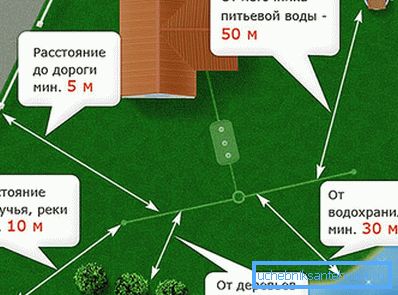
The location of the tank for the accumulation of waste is regulated by sanitary standards. The relief of the site, the groundwater level and the depth of frost penetration are important. Natural norms are individual for private houses, and sanitary standards are universal, their implementation will prevent contamination from waste water and soil.
- The distance from a residential house to a pit without a bottom should be at least 10 m, this is due to the release of harmful gas and unpleasant odors arising from biological processes. Sealed septic tank can be installed in 5 m.
- From the road to the tank should be 5 m.
- Between the trees and the pit - 3 m.
- The source of drinking water in clay soil should be located at a distance of 20 m, sandy - 50 m.
- The distance to the border of the neighboring territory is 1 m.
- From the water mains to the cesspool - 10 m.
It is important to ensure the unimpeded passage of aspenisation machine. The depth of the local sewage system should not exceed 3 m, which will allow pumping out drains completely.
Types of cesspools
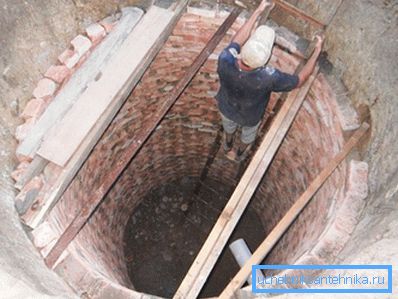
There are two ways to arrange a sewage collection tank:
- A cesspool without bottom is used with a small amount of effluent. In this case, it should not exceed 1 m.3 per day. Installation of this design is carried out quickly and with minimal financial costs. Among the significant drawbacks - its volume is not enough for the needs of the family, the system pollutes the soil and eventually causes damage to the ecology of the site. The use of biologics helps reduce the cost of cleaning the sump.
- The tight tank for drains. Its volume is determined by the number of people living in the house, for a family of 4 people will need a pit at 12 m.3. It is safe and will last a long time. The disadvantage is the fixed costs of pumping out drains.
Stages of construction
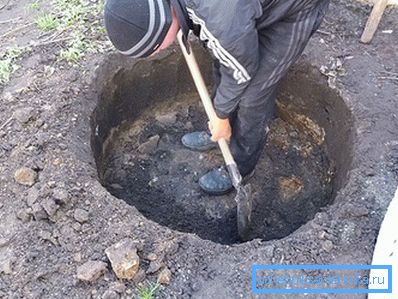
- Having chosen a place according to the rules, they start digging out a pit, its depth will be about 2.5 m. At the same time a trench for a sewer pipe is digging along with the pit. In order to prevent freezing of drains in winter, its depth should not be less than 1 m. It is necessary to create a slope of 2 cm per meter for the water to move with sufficient speed.
- The device cesspools that do not have a sealed bottom, start with the sleep of a drainage cushion of rubble and sand. It should cover the bottom of 30 cm. The walls of the tank are made of brick or cinder block laid in a checkerboard pattern. This scheme allows water to seep into the ground and saves material. The shape of the well is arbitrary - it can be a square of 2? 2 m or a circle with a diameter of 2 m. A broken brick and crushed stone fall asleep along the walls of the circular pit, which will provide additional drainage. In the upper part of the well leave a hole for the pipe. If you want to create a more solid structure, you can use concrete rings for the walls. Before their installation, drainage is performed on the bottom: a layer of sand is poured in 10–15 cm and covered with geotextile, further crushed stone is poured on 30 cm, it is also covered with a geotextile canvas. The material passes water well and protects the drainage from silting, allowing the system to function longer. After installation of the rings, the tank is closed with a stove with a hatch.
- The cesspool is covered with a concrete ceiling with a hatch, which is necessary for inspecting and cleaning when silting the bottom. A layer of earth is poured on top of the overlap, this will serve as additional thermal insulation of the sump.
Pit with overflow

The more complex design of a two-chamber sump allows filtering a significant amount of water. The tank consists of two sections - the first one is hermetic, drains get into it and are divided into solid waste falling to the bottom and light water flowing through an opening in the separation wall into the adjacent chamber. The second compartment is made without a bottom, through the filtering layer of sand and rubble the settled water seeps into the ground.
Such a system is designed for long-term use with periodic pumping by vacuum trucks.
Sealed pit of concrete rings
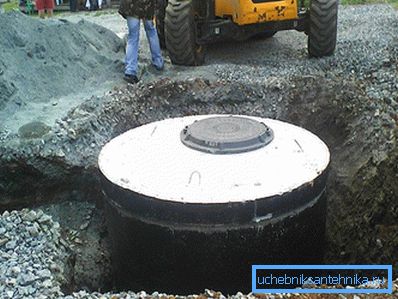
The tight tank from strong material will serve several generations, it is simple in installation and safe in operation. Reinforced concrete withstands the external pressure of groundwater, and it is also resistant to chemicals. For the device of a cesspool of concrete rings will need to attract a crane.
The diameter of reinforced concrete rings can be from 1 to 2 m, it is selected for the volume of wastewater. One of the rings is bought with a concrete bottom, if it is not there, the concreting of the bottom of the pit is carried out independently. A week after pouring the solution, you can omit the rings, which are fastened with metal straps. In the upper ring perforator punches a hole for the pipe.
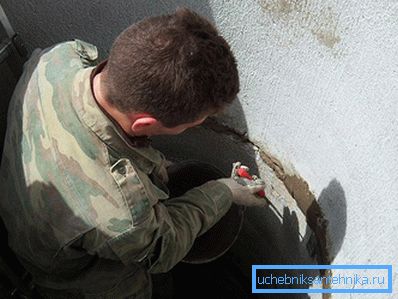
The joints of the products need insulation, on the inside they are covered with cement mortar and liquid glass. If the area has a problem with groundwater, external waterproofing with liquid glass is also necessary.
The space around the rings is filled with sand mixed with rubble - this will protect the structure from moving soil.
The cesspool is closed with a reinforced concrete slab with a cast-iron hatch. For thermal insulation in the winter, it is covered with sand, and above with soil.
Plastic sealed container
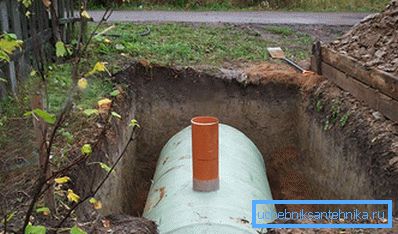
To install a plastic tank you need to dig a hole of the appropriate size and a trench for laying a sewer pipe. This option requires minimal effort. As a septic tank, lightweight and durable polyethylene containers are popular. The volume of the tank is selected on the basis of personal needs, it can be 8-10 m3. While preparing the foundation pit, it is worth digging it with a reserve for backfilling around the container of a protective layer made of a mixture of sand and rubble, which will not allow the soil to affect the plastic.

Of the downsides of this simple and environmentally friendly system is the need for frequent pumping of the septic tank, which means that the fixed costs of the work of the vacuum trucks.
It is easy to dig and equip a cesspool on your site, the main thing is not to forget about the sanitary norms of its location.
Video
See how you can make a cesspool of concrete rings:
This video describes the construction of a brick sump: